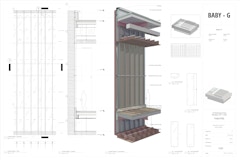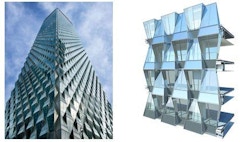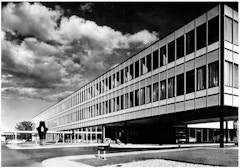280 results
-
The construction industry is one of the greatest sources of pollution, where 39% of global energy-related carbon emissions are attributed to…
-
Saving Small Towns
- Paper by Leah Kemp
Small towns are dying, and it is not just because of their dwindling economies. The physical fabric of our communities is literally crumbling. A
-
Origami-Inspired Facade Design
- Paper by Joshua Schultz, Ph.D, P.E., LEED AP, ENV SP · Neil Katz, AIA
To paraphrase Robert le Ricolias, the art of the structure is where to put the folds. Using that inspiration, fundamental concepts from origami,
-
New Course on Building Façade Design Developed at Oklahoma State University
- Paper by Bodhisatta Hajra, Assistant Professor of Architectural Engineering John Phillips, PE,
A façade, which is also called a ‘secondary structural system’, typically separates the exterior from the interior of a building. In recent times,… -
A Compact, Unitized Double Skin Facade
- Paper by Alex Cox, LEED AP · James Hock, LEED AP BD+C · Laura Ziegler · Karin Lamberts
Driven by an increasing demand for high thermal and acoustic performance, transparency, and low maintenance costs, a number of facade innovations
-

Undulated Glass Self-shading
- Paper by Nebojsa Jakica, Assistant professor in Facade Design and Engineering Mikkel K. Kragh, Professor, Head of Civil and Architectural Unit
The research is structured around complex optical effects of undulated glass and coatings that exhibit high reflectivity, especially at higher… -

Optimized Adaptive Re-Use
- Paper by Matthew Parker · John Souleles
Contemporary building practice represents a disconnect between traditional manufacturing techniques, that favor straight runs and orthogonal
-

Thermal Analysis of Complex Glazing
- Paper by Adrian Turcato · Chris Stutzki · Erik Olsen
The use of bidirectional scattering distribution function incorporated in a transient systems simulation program, allows engineers to accurately
-

Influence of Facade Materials on the Acoustic Environment
- Paper by Alvaro Balderrama, M.Eng. LEED Green Associate · Daniel Arztmann, Prof. Dipl-Ing. M.Eng. · Jens-Uwe Schulz, Prof. Dipl-Ing.
Urban noise pollution is a major environmental health problem. International organizations are making efforts to prevent health damage due to high
-

Smart Colored Window Technology
- Paper by Negar Heidari Matin, negar.matin@ou.edu Seyed Mojtaba Mirabedini, Visiting Professor at Eastern Michigan University Zhina Rashidzadeh, Ph.D. student at Gibbs College of Architecture
Traditional architecture can be a valuable source of inspiration for designers. Sustainable design concepts in traditional architecture have been… -

Digital Medium, Tangible Message
- Paper by Nathaniel Barlam,
The reaches of architecture are inherently linked to the efficacy of communication, and as emerging technology broadens the conceptual horizon of the… -

Systems Thinking
- Paper by Gabrielle Brainard, AIA, LEED AP, CPHC
This paper surveys facade design education in accredited Bachelor and Master of Architecture (B.Arch and M.Arch) programs in the United States. A
-
Influence of Performance and Design of Structural Silicone Joints on the Resilience of Curtain Wall Units Exposed to Seismic Impacts
- Paper by Viviana Nardini · Florian Doebbel
Facade failure due to seismic event represents a potential hazard to people and can cause serious damages to buildings with consequent high-cost
-

International Facade Education
- Paper by James Doerfler, Uta Pottgiesser,
Globalization in the construction industry has brought about new demands for buildings and construction projects, new demands that still need to take… -

Seismic Design of Jumbo Glass Structures
- Paper by Alfonso E. Lopez, P.E., CEO David Dunham, P.E., Director of Business Development
The design of structural glass systems continues to evolve with the parallel development of new manufacturing technology. Improvements in the… -

Pioneering the Structural Terracotta Mullion Façade
- Paper by Victoria Ereskina, Façade Design Professional John Neary, Sr. Façade Specialist
Architects today must explore alternative enclosure materials to meet evolving energy codes and embodied carbon regulations. Terra cotta has been… -
Vintage Vinyl
- Paper by Michael S. Plewacki
Mid-century through 1980’s buildings with lock-strip or “zipper-gasket” glazing systems are an ever present part of the urban landscape in many
-

The Seismic Capability of Curtainwalls
- Paper by Peter Lalas MIEAust CPEng NER APEC Engineer IntPE(Aus)
The testing of aluminum/glass curtainwalls for seismic capability, mainly inter-story drift, has been carried out on many curtainwalls over the last
-

Facade with Innovation
- Paper by YU Hui, Director JIN Shihui, Project Manager
Shanshui City and Star Bund Center can be considered as representative projects of RFR Shanghai recently Both provide creative solutions for complex… -

Preserving a Historic Facade
- Paper by Maria Mohammed, S.E. · John Fidler, RIBA, Intl Assoc AIA, FRICS, FSA, FRSA, FIIC, FAPT
Environmental and socio-economic benefits of sustainable preservation have become apparent most recently in the restoration of the historic former


